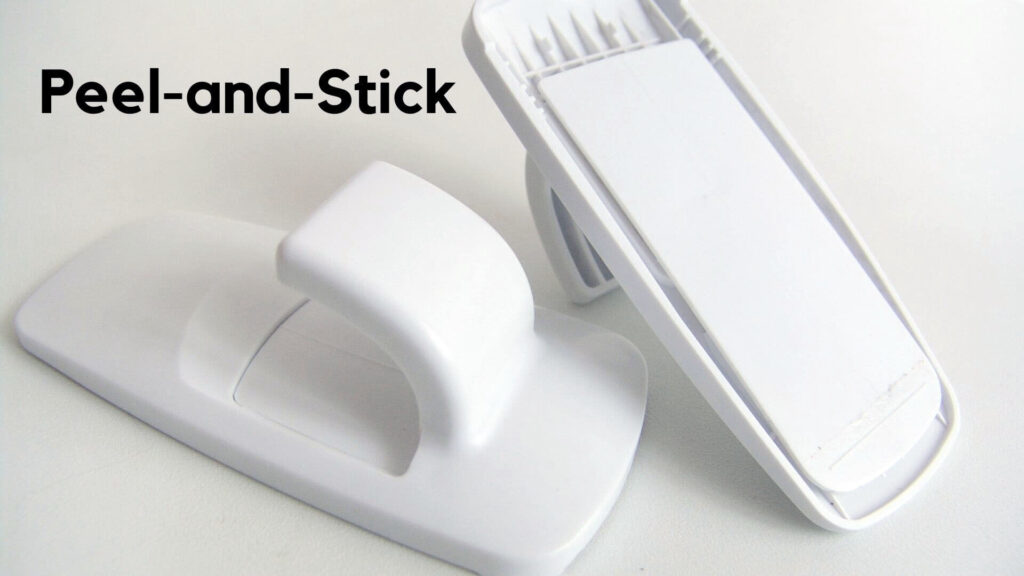Window blinds are an essential component of every home since they block out intense light from the outside but also assist in maintaining privacy by blocking others from looking into your home.
Blinds are fantastic for many reasons. Your room will be kept darker during daylight hours, which will allow you to sleep better–and you will not have the sense that someone is watching you sleep. They’re particularly beneficial if you have a baby or a small child with an early bedtime.
Window blinds, particularly blackout blinds, are frequently challenging to install. If you’re on a tight budget and unable to pay someone to install your blinds for you or have recently moved into leased housing where drilling holes left, right, and center is not an option, It’s not as hard as you may think, but it does require some essential tools and a little bit of patience.
In this article, I will show you how to install window blinds without drilling.
Table of Contents
5 Easy Steps to Go Install Window Blinds Without Drilling
Step 1: Choose The Right Blinds
The first thing to consider when selecting window blinds is the size of the window. Most blinds come in various widths, from 6 inches to 36 inches.
Next, measure the height and width of the window. Blinds with a higher upholstery hanger can be installed over a standard door handle so that they are easy to operate.
Finally, select your fabric style and color. Some fabrics are heat-resistant, while others may fade in direct sunlight.
Step 2: Measure The Window
- Measure the height and width of the window.
- Measure the distance between the top of the window and the ceiling.
- Measure the distance between the bottom of the window and the floor.
- Divide these measurements by 2 to get the height and width in inches, and divide by 4 to get the depth in inches.
Step 3: Purchase The Right Hardware
When installing window blinds, you will need the proper hardware.
- First, measure the width of your window and purchase the right blinds.
- Second, measure the height of your window and buy the appropriate brackets.
- Third, measure the depth of your window and buy suitable screws or nails.
- Fourth, choose a fabric or type of window treatment and purchase the corresponding hardware.
- Finally, install your blinds by following these installation instructions.
Step 4: Assemble The Blinds
First, before you start assembling the blinds, make sure to gather all of the necessary supplies. You will need a Phillips head screwdriver, a drill, and blind installation screws.
Next, remove the Venetian or roller window coverings by unscrewing the four screws that hold them in place. Make sure to label each side of the window so you can reattach them in reverse order when you’re finished assembling the blinds.
Now it’s time to assemble the blinds! Start by attaching one end of the metal frame to one side of the window using a Phillips head screwdriver. Once connected, use your drill to fasten down one set of installation screws on either side of the metal frame.
Check Also: how to hang wall clock without drilling
Step 5: Install The Blinds
Installing window blinds is a relatively easy task. You will need to measure the size of your window and purchase the necessary hardware. Once you have gathered all of your materials, you can begin the installation process.
To install a window blind, first, remove the old blinds. You will need to use a screwdriver to unscrew the knobs on either side of the window.
Next, remove the screws holding the brackets and set them aside. You will then need to remove the fabric from each side of the blinds and slip them over the frames.
Make sure that they are lined up correctly and screw them in place using screws removed earlier.
Now that your new blinds are installed, it is time to adjust them if necessary.
Check Also: how to make a hole in wood without a drill
7 Types of No Drill Blinds
No drill blinds are simple to install and do not require power tools or screws. I will discuss these blinds in greater detail and the many mounting options available for your windows or doors.
1. Clip-In Blinds

Clip-in blinds have been created specifically for use with PVC window frames. These blinds include brackets that slide into the rubber seal on the rear of the window.
The primary advantage of clip-in blinds is that they are simple to install and leave no gaps. These window treatments are ideal for patios and French doors because they require no drilling. Additionally, you can open and close your door after installing these blinds.
2. Peel-and-Stick

Self-adhesive or peel-and-stick blinds are easy to put up and don’t require a lot of time or money to get done. Typically, the bracket’s upper surface is coated with a dab of strong glue and sealed with a protective strip.
It’s as simple as 1-2-3 to install self-adhesive blinds. These blinds include an adhesive strip along the headrail; all you have to do is peel back the ribbon and adhere the blind to the window or door. Press the strip firmly for optimal adhesion.
The majority of individuals prefer to adhere the self-adhesive blind to the inside of their window frame for a tidy appearance.
Self-adhesive blinds are available in various sizes and shapes but are typically only available in two colors: black or white. The fabric is generally made of paper, which makes it easier to trim them to fit the dimensions of your window.
Self-adhesive blinds are much easier to install than conventional no-drill blinds. Additionally, they are pretty convenient for window washing.
The majority of self-adhesive blinds include clips that allow the window treatment to be folded away when not in use. However, the most significant disadvantage of these blinds is that they will not readily come off once attached to the frame, so be sure to position the blind appropriately before pasting it.
3. Magnetic Blinds

Consider magnetic blinds as the optimal interim option. These no-drill window treatments are often applied to the metallic window and door frames using a magnet. The magnet is attached to the door, and the blind is positioned on it. However, how precisely do these blinds operate?
Each side of these temporary window curtains is fastened with a powerful magnet. The blind’s outside interest enables it to adhere to metallic surfaces.
The inner magnet is secured to the internal glass pane of the window using the high-performance adhesive on both sides. This ensures superior adhesion that is correctly aligned with the internal magnet of the blind.
The blind’s slats can be lowered, tilted, and lifted using the outer and inner magnets within the panes. The magnetic slider attached to the window treatment’s borders can be positioned on either the left or right side of the pane to ensure that the window treatment moves in unison with it.
4. Command Strip Blinds
Without drilling, command strip blinds are an economical method to mount your window coverings. Additionally, they work well with glass, wood, drywall, and steel.
Install one side of the strips on the window and the other on the wall or window frame. Although these command strips have a sticky side, they may not adhere well to fabrics; as a result, some users apply additional glue, such as Gorilla glue.
5. Command Hooks
Command hook blinds are the most inventive method of suspending blinds without drilling. These blinds are just as simple to install as the prior no-drill window treatments.
When combined with command strips, the blinds are secured to the window. Install two command hooks on each side and in the center of the window to provide additional support.
Then, using a needle, sew the shade cloth strips or thread to the rear of the blind to create loops. Additionally, you can use a heavy-duty adhesive to provide additional stability.
After securing the hooks to the window, hang the blind by threading the loops through the three command hooks.
A big adhesive strip can support up to 15 pounds, while a small adhesive strip can support up to 5 pounds. Additionally, you can use picture-hanging command strips to help a more significant amount of weight.
The strips can be peeled off and adhered to the window’s sides. Once the command strips are in place, use command hooks to secure the blinds to the stripes. It doesn’t get any easier than that!
6. Tension Rods
Consider tension rods for a more comprehensive selection of no drill blinds. These blinds are suspended from a tension rod inserted into the window trim.
The strain on the rod secures the blind in place. These rods work well in somewhat recessed doors or windows with sufficient space to place the rod.
Tension rod window treatments are available in various styles and designs, including cordless shades, roller shades, Roman blinds, pleated shades, and thermal blinds.
Because tension rods are entirely adjustable, they are compatible with many door and window widths.
However, caution should be exercised when pulling on these rods since the tension may break and the shade may come off.
If you already have blinds installed and seek blackout window treatments, you may want to try installing a tension rod above or behind them. No more holes are required!
7. The Corner Brackets
If your windows have trim, there is another alternative that may pique your curiosity. Corner brackets are explicitly developed for windows that have an edge.
They resemble conventional brackets but do not require drilling into the wall. Additionally, they are a considerably more robust option to handle heavyweights.
As a result, these are an excellent solution for curtains hanging on expansive windows. These brackets are available in various styles to complement any décor style.
Essential Things to Keep in Mind
Before you go online and search for non-drilling alternatives, consider the following variables that may impact your decision.
- When you live in rental housing
- When the curtains to be hung are not particularly heavy.
- When the dimensions and design of your windows are typical
- You don’t mind having fewer alternatives than standard blinds give.
- You are pretty sure that you will handle the blinds delicately.
- You do not wish to do damage to your walls.
It’s never been easier to choose a blind for your windows. You have a plethora of options available to you, and there is something to suit every style and design preference, regardless of technological capability.
Additionally, there is an abundance of information and videos available on the internet to assist you in making an informed decision.
Consider your selections carefully and choose the best one to achieve the ideal blend of design and comfort in comfortable homes.
Check Also: how to cut a circular hole in plastic without a drill
FAQs About How to Install Window Blinds Without Drilling
Can blinds be hung without a drill?
Yes, with no drill blinds. Drill-free blinds snap into window frame brackets. Models are affixed to the window frame using glue or hooks.
These blinds are available in several materials, including aluminum, PVC, bamboo, and wood. It’s time to learn about drill-free blinds and how to hang them.
What’s the point of putting up blinds without drilling?
While hanging blinds with a drill and nails or screws is not the most challenging DIY job, there are numerous reasons to avoid creating holes.
For instance, you may be renting an apartment where the landlord prohibits drilling into the walls. Or perhaps you lack the necessary tools.
Whatever the cause, all you need is a high-quality, high-strength tape to get the job done quickly and easily.
What is the best type to hang blinds without screws?
Due to the weight of blinds – particularly those made of plastic or wood. Because Unibond No More Nails On A Roll provides rapid grip and has a maximum load capacity of 120kg per roll, it is suitable for putting up blinds without drilling holes.
The tape is suitable for a wide variety of household materials, including those found in most blinds, such as PVC, metal, and wood, and it bonds to both porous and non-porous surfaces.
Because it is waterproof and resistant to extreme heat and humidity, it is also suitable for hanging blinds in bathrooms and shower rooms.
Final Thought
Installing window blinds without drilling is a great way to update your home without spending a lot of money. Follow the steps above and you will be able to do it yourself in no time.

Hey, I am Shihab Uddin, I’m a huge fan of DIY crafts. My workshop is where I spend most of my spare time, and I’m always working on some project. To that end, I’d like to share some of my knowledge and experience with you in power tools, woodworking, and other specialized materials fabrication.
I will guide you with genuine knowledge that can assist you with deciding whether a drill is appropriate according to your requirements or not. If you want to find the best drill and know which type of drill is most suited for your needs, then I can guide you with my expertise. My passion lies in helping others find the correct products they need at an affordable price.


